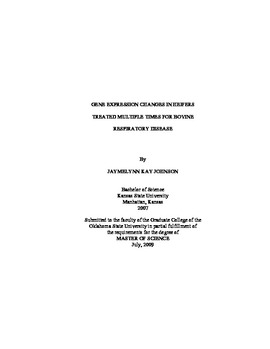| dc.description.abstract | Tissue biopsy samples from the longissimus dorsi muscle (LM) and subcutaneous fat (SCF) between the 12th and 13th rib from heifers never treated against BRD (HLTH; n = 5), treated once (T1), treated twice (T2), treated three times (T3), and heifers classified as chronically morbid (CHR; n = 5) were collected after a 63-d preconditioning period. Chronically morbid was defined as animals receiving at least three antimicrobial treatments and loss of BW during the previous 21 d on feed. Hybridizations were performed between CHR and HLTH using a long oligo bovine array. Significance level for differentially expressed genes was set at P < 0.01 with a twofold change or greater. Of the 186 differentially expressed genes in LM (143 down- and 43 up-regulated) and the 121 differentially expressed genes in SCF (44 down- and 77 up-regulated), 146 and 97, respectively, had known ontology. Differentially expressed genes were mapped to pathways involved in immunological functions, metabolism, catalytic activities, binding, proteolysis, apoptosis, translation, transcription, growth, and transport of nutrients. These differences in gene expression across tissues and between treatment groups will provide a better understanding of the impact BRD has on immune response and animal growth. In experiment two, genes (n = 14) were evaluated using quantitative RT-PCR. Proc Mixed procedures of SAS were used to evaluate significance of number of treatments. In SCF, components of the ubiquitin pathway, F-box and WD repeating domain containing 12 (FBXW12), tended to increase ( P ≤ 0.10) as the number of antimicrobial treatments increased. In addition, expression of FBXW12 tended ( P = 0.10) to be greater and expression of 26S proteasome subunit ATPase 1 (26S) tended to be greater ( P = 0.09) in LM of CHR heifers than HTLH heifers. In LM, fold change expression of tumor necrosis factor-α was greater ( P = 0.01) in CHR heifers than HLTH, T1 and T2; T3 heifers were intermediate. Haptoglobin (HP) expression in SCF was greater ( P = 0.05) in T1 than CHR heifers; HLTH, T2, and T3 heifers were intermediate. Results suggest that genes involved in muscle wasting via the ubiquitin pathways and expression of TNF-α may be activated in morbid heifers. These results could partially explain the decreased growth rates and carcass quality in cattle infected with BRD. | |
